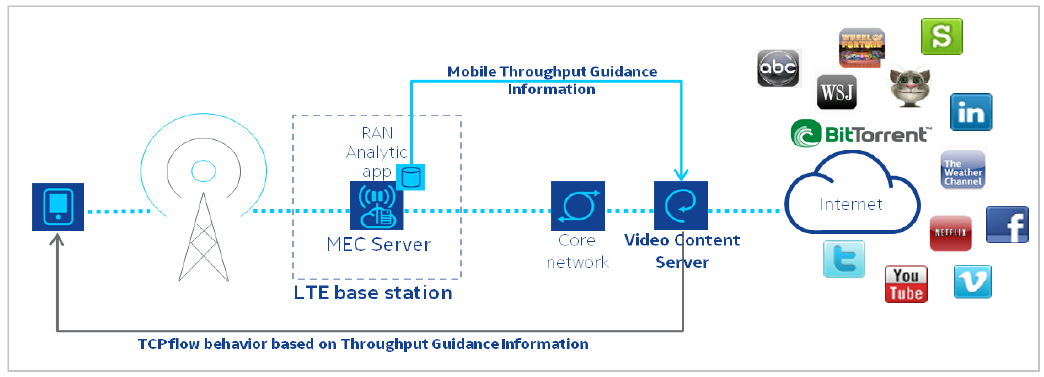MEC多接入边缘计算及关键技术
477 浏览 5 years, 2 months
3.2 智能视频加速 Intelligent Video Acceleration
版权声明: 转载请注明出处 http://www.codingsoho.com/End user Quality of Experience (QoE) and utilization of radio network resources can be improved through intelligent video acceleration. Internet media and file delivery are typically streamed or downloaded today using Hypertext Transmission Protocol (HTTP) over the TCP protocol. Available capacity can vary by an order of magnitude within seconds (as a result of changes in radio channel conditions, devices entering/leaving network). TCP may not be able to adapt fast enough to rapidly-varying conditions in the radio access network (RAN). This may lead to under-utilisation of precious radio resources and to a sub-optimal user experience.
Figure 4 shows an example of the intelligent video acceleration service scenario which attempts to overcome the challenges described above. In this scenario, a radio analytics application, which resides in a MEC server, provides the video server with an indication on the throughput estimated to be available at the radio downlink interface. This information can be used to assist the TCP congestion control decisions (for example in selecting the initial window size, setting the value of the congestion window during the congestion avoidance phase, and adjusting the size of the congestion window when the conditions on the "radio link" deteriorate). The information can also be used to ensure that the application-level coding matches the estimated capacity at the radio downlink.
The video server may use this information to assist TCP congestion control decisions (for example by ensuring that the application level coding matches the estimated capacity at the radio downlink). The content’s time-to-start as well as video-stall occurrences can be reduced, enabling improved video quality and throughput.

Figure 4
终端用户的体验质量(QoE)和无线网络资源的利用可以通过智能视频加速来提高。今天,通常使用基于TCP协议的超文本传输协议(HTTP)来流式传输或下载Internet媒体和文件传递。可用容量可能会在几秒钟内变化一个数量级(由于无线电信道条件的变化,设备进入/离开网络)。 TCP可能无法足够快地适应无线电接入网络(RAN)中迅速变化的条件。这可能导致宝贵的无线电资源利用不足,并导致次优的用户体验。
图4显示了智能视频加速服务方案的示例,该方案试图克服上述挑战。在这种情况下,驻留在MEC服务器中的无线电分析应用程序为视频服务器提供了估计吞吐量的指示,该吞吐量估计在无线电下行链路接口上可用。此信息可用于协助TCP拥塞控制决策(例如,在选择初始窗口大小,在拥塞避免阶段设置拥塞窗口的值,以及在“无线电”上的条件满足时调整拥塞窗口的大小。链接”恶化)。该信息还可以用于确保应用程序级别编码与无线电下行链路上的估计容量相匹配。
视频服务器可以使用此信息来辅助TCP拥塞控制决策(例如,通过确保应用程序级别编码与无线电下行链路上的估计容量匹配)。可以缩短内容的开始时间以及视频停顿的时间,从而提高视频质量和吞吐量。